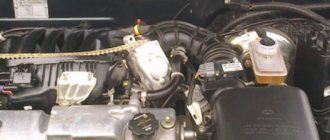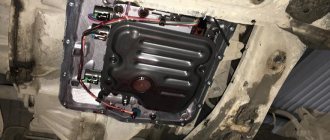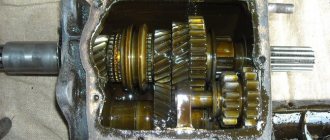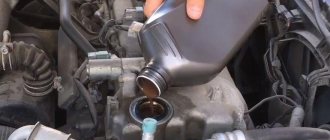At what temperature should the automatic transmission operate?
An automatic transmission contains ATF, which acts as a torque-transmitting link between the engine and the wheels.
During automatic transmission operation, the transmission fluid heats up, which can heat up other elements of the gearbox. This can lead to resulting overheating if used incorrectly. It is believed that the optimal ATF temperature for automatic transmission operation is between 65 and 100 degrees Celsius. If the temperature of the liquid in the box exceeds, there is a high risk of damage to its components.
Please note: A radiator is used specifically to cool ATF fluid in modern cars, through which the fluid flows and is cooled.
What does overheating of automatic transmission fluid lead to?
As noted above, overheating of the ATF fluid in an automatic transmission can lead to a number of serious problems. Let's look at the most common of them:
- Loss of ATF fluid properties. Transmission fluid has a temperature operating limit of about 130 degrees Celsius. If the liquid is heated to higher temperatures, this leads to a loss of its properties. A similar problem can be accompanied by the formation of sediment, which becomes clogged in various working elements of the gearbox - valve bodies, solenoids, and so on. Accordingly, such a problem will lead to a decrease in the quality of the gearbox.
- Damage to friction discs. One of the most common problems with automatic transmissions is damage to the friction discs. Depending on the design features of the unit, friction discs can be made of metal or more plastic materials. The lower the quality of the friction discs, the more likely it is that they will burn out when the automatic transmission operates at elevated temperatures.
- Damage to solenoids. Because automatic transmission solenoids are often made of plastic, they are not designed to handle temperatures above 100 degrees Celsius. When the oil is heated at high temperatures, the solenoids through which it passes to close or open the clutches can simply melt, which will lead to difficulties in their operation.
- Destruction of wiring. There may be wires going to the solenoids in the automatic transmission that are also destroyed by high temperatures.
Let's go to settings
After installing TORQUE PRO + Advanced EX . We need to set everything up correctly to read the automatic transmission temperature.
We connect the ELM327 to the car (in the OBD2 connector), then establish a connection via Bluetooth or via WIFI (depending on what version you have)
Let's go to the program.
Now we need to go to Advanced EX (it will be a separate icon). Click CAR MODEL and select your car from the list. Let's say KIA RIO 1.6 engine
SAE viscosity classification of transmission oil
The SAE index, which indicates the viscosity of transmission oil, was developed by the American Society of Engineers. This standard has become widespread throughout the world and today the SAE J306 specification is used to determine the viscosity classification of motor oil for drive axles and manual transmissions. This qualification also determines the temperature range at which the use of a particular lubricant is permissible.
The lowest and highest temperature at which a car can be operated has its own limit, which is estimated:
- at the temperature at which the Brookfield viscosity of the liquid reaches 150,000 cP (centipoise);
- by the temperature at which the kinematic viscosity of the “transmission” is determined at a temperature of 100 degrees.
Thanks to this, it is possible to determine the load (approximate) that the protective oil film can handle.
According to SAE standards, transmission oils are divided into categories similar to motor lubricants:
- winter (W, Winter): 70w, 75w, 80w, 85w;
- summer (without index): 80, 85, 140, 250.
All-season fluids have both markings, for example, SAE 75w-85. These oils can be used throughout the year. As you can see, in this regard, “transmission oils” are similar to motor oils, but this does not mean that these petroleum products are used under the same conditions and have the same performance. The same applies to questions about whether it is possible to pour the “transmission” into the engine and vice versa. Motor oil can be used for gearboxes, but transmission fluid cannot be poured into the engine.
Table of ambient temperature ranges in which transmission oils can be used. The most commonly used types of oils are indicated
| Minimum temperature at which lubrication of components is ensured, °C | SAE class | Maximum ambient temperature, °C |
| -40 | 75W-80 | 35 |
| -40 | 75W-90 | 35 |
| -26 | 80W-85 | 35 |
| -26 | 80W-90 | 35 |
| -12 | 85W-90 | 45 |
ELM327 is not omnipotent
I just want to make you understand that the ELM327 is an ordinary scanner; without software it is worth nothing (it won’t show it to you). That is, when you connect it to the OBD2 connector and even establish a connection with a smartphone, tablet, laptop, nothing will happen
You also need to install a program that can work with your car's ECU
Only then will you be able to clear errors, read temperature, mileage, remove CHECK ENGINE , etc.
Storage conditions for transmission oil
Gearbox lubricants have a warranty period of 5 years, and in some cases 3 years. After this period, the additives contained in the liquid lose their properties and, accordingly, such expired oil will not meet the necessary requirements.
It is worth noting that the period of 3-5 years indicates the shelf life of automobile oil in unopened containers. If you have already opened the bottle, the shelf life of the liquid will depend on many conditions. In order for the composition to remain effective longer, you must adhere to the following recommendations:
- avoid temperature changes; the liquid must be stored at a constant temperature not exceeding 20 degrees;
- the oil should be stored in a well-ventilated area, away from direct sunlight;
- It is not recommended to pour the lubricant into another container; it is better to store it in the factory canister with a tightly closed lid;
- Do not freeze the transmission under any circumstances.
If these conditions are met, the oil will be stored for the entire stated period.
Some car enthusiasts “revive” expired oil with special additives. This is not recommended, since “live” additives may remain in the liquid and with such mixing their quantity will change, which, in turn, will no longer meet the standards. In addition, new components can enter into a chemical reaction with old additives, as a result of which their properties will be unpredictable.
Many people mistakenly believe that if the “transmission” has changed its color, then this is the main sign that the fluid is unsuitable. It is not always so. The fact is that during the production process the main parameter is the lubricating characteristics of the composition, so some deviation in color or smell is acceptable. However, if not only the color has changed, but also a dark crystalline precipitate has appeared, and the oil itself has become cloudy, then such a product cannot be poured.
It is also worth saying that storing transmission or motor oil in a barrel or car system are two different things. In the second case, the lubricant is constantly in contact with the environment, as a result of which oxidation processes occur and various deposits appear. Therefore, even if you pour new oil into a car without mileage, this does not mean that you can change it after 5 years. A scheduled gearbox oil change depends on operating conditions, but experts recommend changing the fluid every 70,000 km during normal operation of the system and after 25 000 km when driving in special conditions (heat, cold, full load, etc.).
Basic automatic transmission faults
Automatic transmission is widespread all over the world. Owners of cars equipped with an automatic transmission note its convenience. This is a very important criterion, especially in urban environments with high-quality road surfaces and constant traffic jams. But like all complex mechanisms, automatic transmissions can have malfunctions. They can affect the electronic, mechanical and hydraulic system of the box.
Electronic malfunctions of the automatic transmission
There may be breakdowns in both the electronic control unit and the motor itself. The most common problem is shorted wiring. If parts of the device malfunction, the on-board computer activates emergency programs and can signal the malfunction to the driver. This happens in the event of a serious malfunction associated with the launch of the box actuator. The transition to emergency mode is characterized by the inclusion of third gear. Only in this case can you get as safely as possible by car to a car service center or a place suitable for repairs.
Mechanical faults of the automatic transmission
This type of malfunction is caused by wear of gears and shafts. This also includes damage to friction elements, such as brake bands, torque converter, lock-up clutch, and hydraulic unit.
The problem that has arisen must be resolved immediately, because... one breakdown leads to another. Professionals explain that this state of affairs is due to the peculiarities of the automatic transmission. During use, friction clutch discs wear out. Small particles (crumbs and chips) of which contaminate the oil, which leads to clogging of the valves and oil channels of the hydraulic unit. As a result, the unit is unable to operate normally and leads to overheating. In the absence of timely measures taken, the gearbox begins to crumble and its repair is not advisable.
Automatic transmission temperature via elm327. How to find out? Step-by-step instruction
The most common scanner for a car is ELM327, for those who don’t know what it is, you can go and read it. It allows you to read a huge number of different parameters for fuel consumption, mileage, various errors (by the way, they can be “reset” through it), as well as temperature values. Nowadays there are a huge number of cars that have an automatic transmission, and the most popular is the classic torque converter automatic. This is a fairly reliable type of “box”, but overheating can destroy it. Therefore, you should always monitor the temperature of the automatic transmission. But this is not very easy to do on modern machines (there are simply no devices that display it). BUT it’s not scary, we have an ELM327, I’ll tell you how to set it up and find out what parameters the “automatic” works with. As usual there will be a video version at the end...
THE CONTENT OF THE ARTICLE
Setting up the ELM327 to read the automatic transmission temperature is not so easy; standard applications do not have such a function, so you have to look for it.
Causes
The most common thing is a low oil level (see the article “How to check the oil level in an automatic transmission), which creates insufficient pressure in the system, or the problem may lie nearby - the gearbox oil pump will soon fail, i.e. He can no longer cope with his work.
What really happens in 90% of cases is that the oil has not been changed for a long time and has long lost its properties. Hello to all the thrifters who don't take care of their cars and don't want to invest money in the simplest maintenance.
Ideally, the replacement interval is around 150,000 km (maximum 200,000 km). If the car was purchased second hand recently, it is better to play it safe and change it. In general, it is good manners to change all fluids immediately after purchase - this is an additional guarantee that everything will be fine with you. And the seller can say anything.
Has anyone been towed recently? So much for overheating from the load. Let the car cool down, flush the radiator, if the sensor lights up again, consider it your own fault. You can't tow anyone with an automatic (unless it's a full-fledged SUV, but even there there are limitations).
Slipping. Stuck? In sand, in snow, in mud - there is no difference. The maximum heating comes from spinning. Well, if your machine can go into emergency mode, consider that the engineers saved you from stupidity. But if there is no such function, or it’s broken, it’s your own fault. Automatic transmission is a very capricious thing and does not forgive such an attitude towards itself.
Another least likely option is that the automatic transmission radiator is clogged, in which case there is simply no place for the heat to escape. There are 2 options - either rinse it well or replace it.
As a rule, it is located next to the engine radiator. Falling leaves, dust, fluff, beetles, etc. clog the honeycombs. We don’t understand why, but when washing a car, few people decide to wash the engine, at most rinsing the main radiator through the grille. All this needs to be washed at least 2 times a year, or even more often, and there is no parallel with the year of manufacture of the car.
What to do if the oil in the box is overheated
Providing first aid when signs of an increase in operating temperature appear will help maintain the functionality of the unit.
AT or AT Oil Temp icon flashes while driving
In this case, you need to reduce the speed and wait until the automatic transmission has cooled to normal operating temperature and the light goes out.
Flush the cooling radiators
It is recommended to clean the outside of heat exchangers at least once a year. Dirt is washed off with jets of water under pressure or a mini-wash, the main thing is not to damage the honeycombs with high pressure. For greater effectiveness, use car shampoos.
Change the automatic transmission oil
The oil level and quality are checked with the engine running and the selector in position “P”, having previously driven 10-20 km. The top marks on the dipstick labeled “Hot” indicate the correct ATF level.
Automatic transmission oil differs from other fluids in red or light yellow color. When checking with a dipstick, the red color indicates the good condition of the oil. Increasing shade to dark indicates levels of dirt and wear. Black - signals aging and unfitness.
You can change the oil completely using the device or partially even in maintenance-free boxes. For a partial replacement, remove and wash the pan, drain up to 50% of the liquid, change the oil filter, install the pan and fill in fresh oil in the amount drained. The procedure is repeated 2-3 times.
If the ATF has recently been changed to a different brand, it is possible that it is not suitable in viscosity and does not cope with the operating temperatures of the transmission. You can view the manufacturer's recommendations for choosing a composition on the automatic transmission dipstick, on the table under the hood and in the instructions.
If none of the options help, and the operating temperature does not drop to normal 75-95℃, you need to diagnose the car.
Consequences
The first to take a hit from the increased temperature of the automatic transmission are the solenoids and clutches. Even 15 minutes of operation in this mode is enough to sharply reduce the life of the machine or hint at the need for major repairs.
In our age of computers, the sensor will report that trouble has crept up unnoticed. It’s up to the driver to decide what to do with this information; there are only 2 options:
1. The cheapest, most rational and optimal way is to call a tow truck and use it to get to the service station.
2. Let the car cool for 10 minutes, drive until the next sensor reading, and repeat the procedure until the car is in the right place.
There is also a third option, give up and move on, only on the way you will hear how your money and time are burning.
In any case, you need to let the automatic transmission cool down, especially if this happened in the summer.
If we are talking about classic four-speed automatic transmissions, then their operating temperature is in the range of 65-95°C. Anything higher begins to eat up the resource.
The best ATF oil operates at a maximum of 130°C (but who pours the best? Consider the standard - 110°C). After this (or close to it), it not only loses its properties, but also begins to produce sediment, which already clogs the entire system.
The clutches on old automatic transmissions are made of normal metal and will not break immediately when the temperature rises, but the automatic transmissions are newer, they are made of pressed cardboard, and they really don’t like high temperatures. So read about your machine on the Internet, what everything is made of inside.
Solenoids on new cars are made of plastic. What does it do when it heats up? Right
Consequences of overheating
Due to wear of the working fluid and an increase in operating temperature, torque loses efficiency, reducing the dynamic properties of the car. For example, when overtaking, the driver frantically presses the gas pedal, but due to the slow operation of the transmission, the maneuver will slow down until the car reaches the required speed to accelerate.
Impact on structure
Operating the gearbox at an operating temperature above 95℃ leads to rapid wear of automatic transmission components. Transmission fluid loses its properties at a temperature of 120-130℃ and becomes less viscous. Friction dust and other wear products quickly deposit in pipeline channels, parts and the radiator. Bearings, gears and shafts are not lubricated effectively. Friction increases. The unit is not working correctly, bringing the time for overhaul or replacement of the automatic transmission closer.
The friction discs rotate freely until a signal to change gear arrives. At this moment, under ATF pressure, the clutches are compressed and fixed in the desired position. Without full compression, the soft clutches slip against the metal discs and become charred due to high friction.
Modern designs of valve bodies and solenoids have plastic housings and bushings. Without lubrication, these parts melt at elevated temperatures. The element fails. In addition, automatic transmission sensor wiring runs near the solenoids, which is also damaged by high temperature.
Symptoms
- The smell of burnt oil in or around the car;
- Kicks when changing gear;
- The switching itself occurs only at high speeds;
- The overheating sensor on the panel is on;
- Or all at once.
What to do?
If you don’t have money for a service station, but you have hands and brains, then you need to start with the cooling system. The idea is simple - you need to flush the valve body and cooling radiator. No special skills are required here, but depending on the car, you will have to buy some tools.
The next step is to change the oil. Even if you changed it 10,000 km. back. Who will guarantee that this is not a fake? It doesn’t cost that much, and if you do everything yourself, consider that in any case it will be cheaper than the services of a master at a car service center, stop saving on everything.
Have you done everything and it didn’t help? Then either the box has already become unusable, or the problem lies deep in technical terms. There is only one road left - to the service station. Either they will revive it normally (if nothing critical has happened), or they will give it another couple of thousand kilometers so that they have time to sell the car, or they will give you contacts where it would be best to order a contract one, or, as they wrote at the very beginning, they will offer to install a mechanic.
Deciding on the program
To begin with, a small remark - I have no task to advertise any program, there are hundreds, if not thousands, of them. I'll just tell you which ones it really works for.
The most popular is TORQUE (it was one of the very first and most adequate):
LITE versions - it's free, but it doesn't do much, it's literally a basic set.
PRO version - this is a more advanced version, but often again it cannot read the temperature of the automatic transmission
By the way, you can watch other programs. For example, on many KIA RIO or Hyundai Solaris, the program CAR SCANNER (IT IS FREE) perfectly shows the temperature of the automatic transmission. However, I would like to note that for some reason it doesn’t work on my KIA OPTIMA
BUT TORQUE PRO itself does not allow you to read the temperature on many automatic transmissions (only FORD, CHEVROLET and a few others are included in the program itself)
Therefore, you need to download and install the so-called “Advanced EX”, this is an extension for various brands.
That is, in order for me to read my automatic transmission (and I have a KIA car), I need to download “Advanced EX for KIA”. Just type it into GOOGLE PLAY and search. Then you install, the extension automatically appears in the TORQUE program itself. If you have other brands, TOYOTA, NISSAN, etc. We are looking for an extension for our cars
BUT! It is worth noting that the program is paid. PRO version costs 165 rubles + “Advanced EX” extension – 399 rubles. That is, you will have to pay 564 rubles
BUT those who are looking can find it on the Internet for free. Although I urge everyone to buy only licensed software, and the money is not global
How to detect automatic transmission overheating
Overheating of the automatic transmission is accompanied by the following symptoms:
- The automatic transmission “kicks” when changing gears - you feel shocks and jerks that were not there before;
- Gears are switched at higher speeds;
- Gear changes are not always timely;
- Some gears may not be engaged, for example, from the second the box will immediately jump to the fourth;
- The overheating icon is on on the dashboard;
- There is a smell of burning ATF.
On some car models, it is possible to find out basic information about the operation of components through the on-board computer. This information often includes the temperature of the fluid in the gearbox. As noted above, if the operating temperature exceeds 100 degrees Celsius, this indicates overheating.
Please note: On cars that do not have a default function for monitoring the automatic transmission fluid temperature, you can install a special diagnostic device, for example, ELM 327, which allows you to monitor the basic parameters of the car, including the temperature in the automatic transmission.
How to avoid overheating of oil in automatic transmission
Enlarge the cooling circuit. Installing an additional automatic transmission radiator will help avoid an increase in operating temperature and extend the life of the automatic transmission. In cars where the automatic transmission radiator is built into the main cooler, an additional section is cut into the general circuit and mounted on the outside of the radiator.
The choice of heat exchanger size must be justified. Too large will be costly to maintain, while a small one will not help regulate the operating temperature.
Radiator manufacturers recommend following the following calculations:
Initially, the cooling circuit is designed for a specific thermal power, and installing an additional radiator upsets the balance of heat transfer, i.e. In winter, it will take longer to warm up the automatic transmission. To solve this problem, thermostats are installed on the way to the additional heat exchanger. The system will be able to connect the cooler automatically when the threshold of dangerous operating temperature of the automatic transmission oil is reached.
If the transmission radiator is mounted on the main one, then before installing an additional structure, you need to check the condition of the existing ones. It may be enough to clean or replace them.
Take care of your car
Changing the ATF every 40-60,000 km will help avoid the dangers caused by rising operating temperatures. The maintenance schedule depends on the car brand. Thus, 6-speed automatic transmissions produced by ZF are installed on BMW and Range Rover. BMW calls its gearbox maintenance-free, and Range Rover recommends lubrication every 60,000 km.
Source
| Shocks when changing gear | Heated oil, contaminated with wear products, clogs the solenoids and thin channels of the valve body, which leads to a drop in pressure. The friction discs stop compressing and slip against each other, which leads to rough operation of the box. |
| Gear shifts are delayed | |
| Upshift is reset to downshift | |
| Burnt oil smell | ATF started to burn. |
How to solve the problem of automatic transmission overheating
First of all, if the box overheats, you need to start with diagnosing the automatic transmission. An integrated approach usually allows you to quickly determine the cause and find out why the automatic transmission is heating up.
Often, to eliminate overheating of the machine, you need to clean the valve body channels, change the transmission fluid and filters, and flush the automatic transmission oil cooler. For cleaning, you can use different methods, ranging from using flushes to disassembling the unit.
Another effective way to solve overheating problems is to install an additional automatic transmission cooling radiator with a thermostat. Such a radiator allows you to quickly reach operating temperature and continue to maintain the heating of the oil in the machine no higher than 70-90 degrees.
Taking into account the fact that many modern automatic transmissions can normally heat up to 100-110 degrees, experienced car owners install an automatic transmission add-on radiator not in case of urgent need, but for the purpose of prevention and increasing the service life of the gearbox.
We also recommend reading the article about why an additional automatic transmission radiator is needed. From this article you will learn why overheating of the oil in an automatic transmission is dangerous, as well as how you can improve the cooling of the automatic transmission. Malfunctions of the engine cooling system itself can also affect the cooling efficiency of the automatic transmission. The fact is that these systems on many cars are partially interconnected (especially when the automatic transmission radiator is integrated into the radiator of the internal combustion engine cooling system).
Finally, we note once again that the heating of the gearbox also depends on the quality and properties of the gear oil. This must be taken into account separately when choosing ATF. Also, do not forget about the need to regularly flush the automatic transmission radiator when changing the oil, and also change the automatic transmission oil filters.
Causes of overheating
The main problems leading to an increase in operating temperature are driving style and the quality of car care.
Automatic transmission overheating above 95℃ is observed when:
- pushing in traffic jams;
- driving in hot climates;
- slipping at high speeds;
- towing a trailer or car;
- going uphill.
If the operating temperature of the automatic transmission increases when driving without load, then the reasons may be the following:
- the main cooling radiator is dirty;
- automatic transmission radiator clogged;
- the oil level is below or above normal;
- It hasn't been changed for a long time or the wrong fluid has been added.
Radiator problems
The cooling capacity of the radiator in hot weather and in traffic jams is reduced because the air flow for blowing is too weak. In addition, the heat exchanger honeycombs are constantly clogged with debris arriving from outside: fluff, insects, dust. As a result, the radiator does not fully dissipate the vehicle's heat, and the operating temperature rises.
The automatic transmission cooling circuit is built into the engine radiator. Taking into account the fact that antifreeze in the main heat exchanger can heat up to 100℃, the radiator of the machine will not be able to cool the ATF to the required operating temperature.
Increased loads
Automatic gear shifting during prolonged slipping leads to high system overloads: in pursuit of transmitting high torque, the operating temperature of the oil in the torque converter quickly increases.
Oil quantity
If there is a lack of ATF, the pump picks up air. The resulting oil-air emulsion has a low heat capacity, is easily compressed, and the quality of the lubricant decreases. Due to high friction, the operating temperature of the automatic transmission begins to rise.
If there is excess liquid, then at high speeds it foams, increases in volume and splashes out. As a result, the oil level decreases and the situation described above occurs.
ATF quality
Manufacturers regulate partial or hardware replacement of automatic transmission fluid every 60,000 km. Taking into account the change of seasons, the quality of roads and driving style, the frequency of oil changes should be reduced to 30-40,000 km.
What will happen if you ignore the recommendations: after 100,000 km, the oil will become saturated with slag and metal shavings, lose its properties, and the unit will stop working normally.











